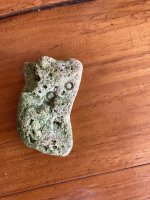cajundetector
Hero Member
- Mar 4, 2023
- 928
- 1,795
Found today in courtyard gravel were at my work. Enlarge and you can see lines coming from circle. From what I researched it’s a type of crinoid fossil. If anyone has different thoughts please feel free to let me know as I do not have a lot of guidance except the internet and a couple of friends. Thanks for viewing.


Upvote
5




